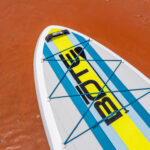Bote LowRider Aero 11’6 iSUP Review
The BOTE LowRider Aero is available in two sizes; 10’6 and 11’6. In this review we will focus primarily on the 11’6 to set the scene, then discuss the 10’6 in its own section at the end.
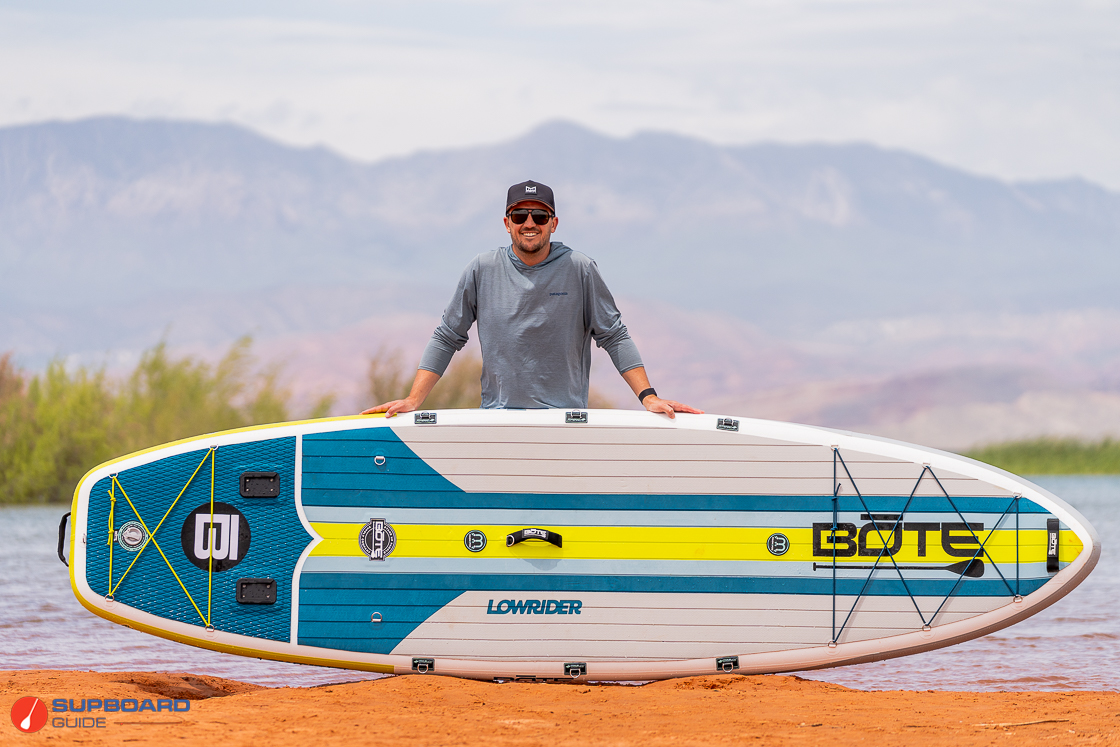
Leading US brand BOTE has got into SUP/kayak hybrids in a big way, with no less than three in their current range. The LowRider Aero comes in two sizes; the 10’6 is packaged as a solo iSUP/kayak hybrid, but for the main body of this review we want to concentrate on the Bote LowRider Aero 11’6 Tandem, which has taken the iSUP/kayak hybrid concept to the next level, coming complete with not one but two kayak rigs, so that you’ve got everything you need to get out there and paddle with a buddy.
However, we see this as much more than just a tandem paddling machine. A board with this size and stability offers a super stable platform for a wide variety of other paddleboarding activities, as we’ll explore in this review.
So from here on, our discussion, analysis and scores are focussed on the 11’6 Tandem. We’ll discuss how the 10’6 differs in a separate section at the end of the review.
We think the BOTE LowRider Aero 11’6 Tandem would be a great SUP for paddlers who:
- Wants to go paddling with a buddy (either sitting or standing)
- Wants a versatile platform for all sorts of on-water fun
- Wants a board that will be ultra-easy to learn on, but also capable of a lot more
- Loves the idea of all that stability
BOTE LowRider Aero Tandem: Spec Sheet

- Board Category: SUP/kayak hybrid
- Listed Board Dimensions: 11’6 x 36” x 6”
- Measured Board Dimensions: 11’6 x 36” x 6”
- Listed Board Weight: 30 lbs (not including seats)
- Actual Board Weight (not including seats): 24.6 lbs
- Listed Max Capacity: 500 lbs
- Recommended PSI: 10-15 psi
- Fins: slide-in center fin, 2 fixed side fins.
- Paddle: 4 piece carbon/fiberglass SUP/kayak paddles
- Board Shell Construction Materials: Single layer PVC
- Drop-stitch type: Knitted
- Price Range: $899
- Warranty: 2 year limited warranty
Performance Review of the BOTE LowRider Aero Tandem 11’6 Stand Up Paddle Board

Overall Score: 9.2/10
- Stability: 9.5/10
- Speed: 8.1/10
- Tracking: 9.2/10
- Maneuverability: 8.1/10
- Construction Quality: 8.5/10
- Features/Accessories: 9.0/10
Stability Rating: 9.5/10
The Bote LowRider Aero 11’6 Tandem is designed to have two people on board. So for a single paddler (even an extremely large one), there is plenty of stability to spare! The massive 36” of width (which is as wide as paddleboards get, other than novelty designs), coupled with the 11’6″ length makes this an exceptionally stable platform.
Bote actually claims that the board can handle 500 lbs of weight. This isn’t something we have been able to verify but it’s probably about right if referring to a spread-out weight, as would be the case when two people are on board or we’re talking rider plus cargo. In which case, a combined weight of 500 lbs should be feasible. Indeed, we were very impressed by how stable the board feels while in kayaking mode.
However, if you’re a solo paddler much above 350 lb then the LowRider Aero 11’6 might still be a little too tippy for your requirements. Being of single layer construction, the board does have a more pronounced degree of flex than boards with double layer construction, (as used in the boards in the Bote range featuring the AeroBOTE construction). A board with more innate rigidity would be a better bet for the extra-heavy paddler.
Nevertheless, there’s no doubt at all that this is a super stable machine, in terms of both primary and secondary stability. You can walk around on it, including right back to the tail, without feeling as though you’re in any danger of falling off.
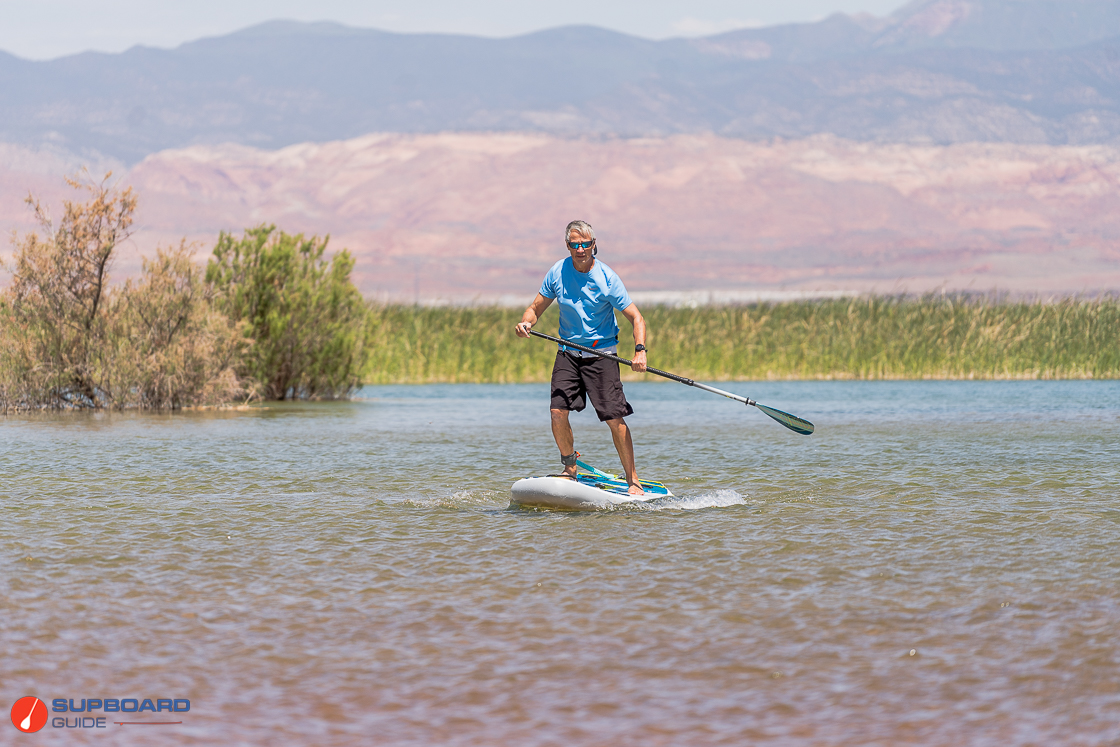
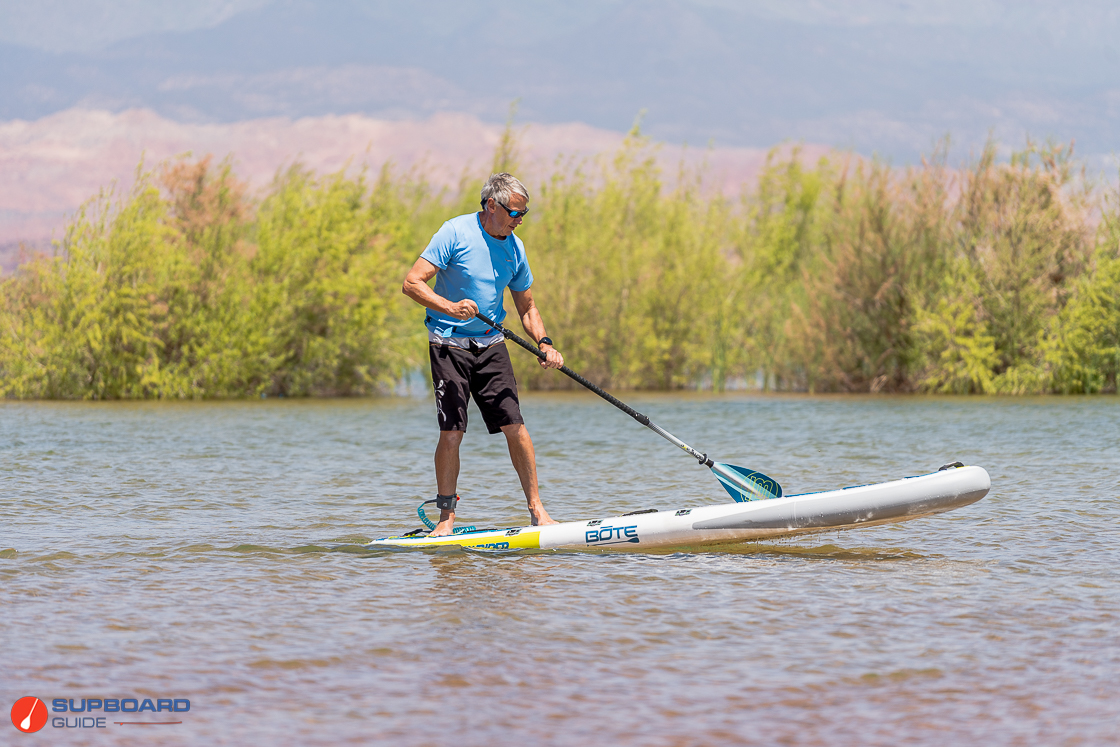
Speed Test: 8.1/10
| Board | |
| Sprint Speed: | 5.2 MPH |
| Average Cruising Speed: | 3.5 MPH |
To obtain our speed test results, we use a Speed Coach SUP 2 device from NK Sports. This gives us accurate real-time readings on how fast we are paddling and our stroke rates. For the top sprint speed, we paddle as hard as we can for approximately 10-15 seconds and then record our average speed. For the casual test, we paddle at 35-40 strokes per minute for approximately 30-60 seconds and record the average speed.
We have learned over the many years of reviewing iSUP boards that there are some areas of performance where physics always wins. There simply isn’t a way of making a wide board fast; the drag from the extra width will always be a factor.
So we weren’t expecting anything too special from the LowRider Aero 11’6. Nevertheless, Bote has done a good job in getting the best out of the board’s plan shape. The extra foot of length over the 10 ‘6 version (and other similar designs in the Bote range such as the EasyRider), gives the board a smoother line through the water. The light weight of the construction also helps, giving the board a reasonably lively feel. The result is an average cruising speed of 3.5mph, which is typical of boards of this size. Without the side fins the board would undoubtedly be a bit faster still.
When you step it up a bit, the extra length again helps give the LowRider a bit more speed, but the extra flex from the single layer construction can also be felt. The board could be pushed to above 5 mph with effort, but the flex really starts to become an issue the harder you go.
In kayak mode, the board moves across the water nicely, with the flex being much less of an issue. If you’re kayaking solo, we’d strongly recommend rigging up a footrest between the front seat fixings, which will make paddling a whole lot more comfortable (indeed you can actually use the second seat to achieve this function).
If you’re planning on kayaking two-up, you may find the seats a little too close together if the person at the back is tall. The person at the front won’t have the benefit of any foot brace either. Nevertheless, once you get your paddling coordinated you can certainly get the board moving at a fair old rate in this mode! We didn’t get a specific speed reading for this, but you could certainly cover a fair amount of ground pretty quickly.
Tracking: 9.1/10

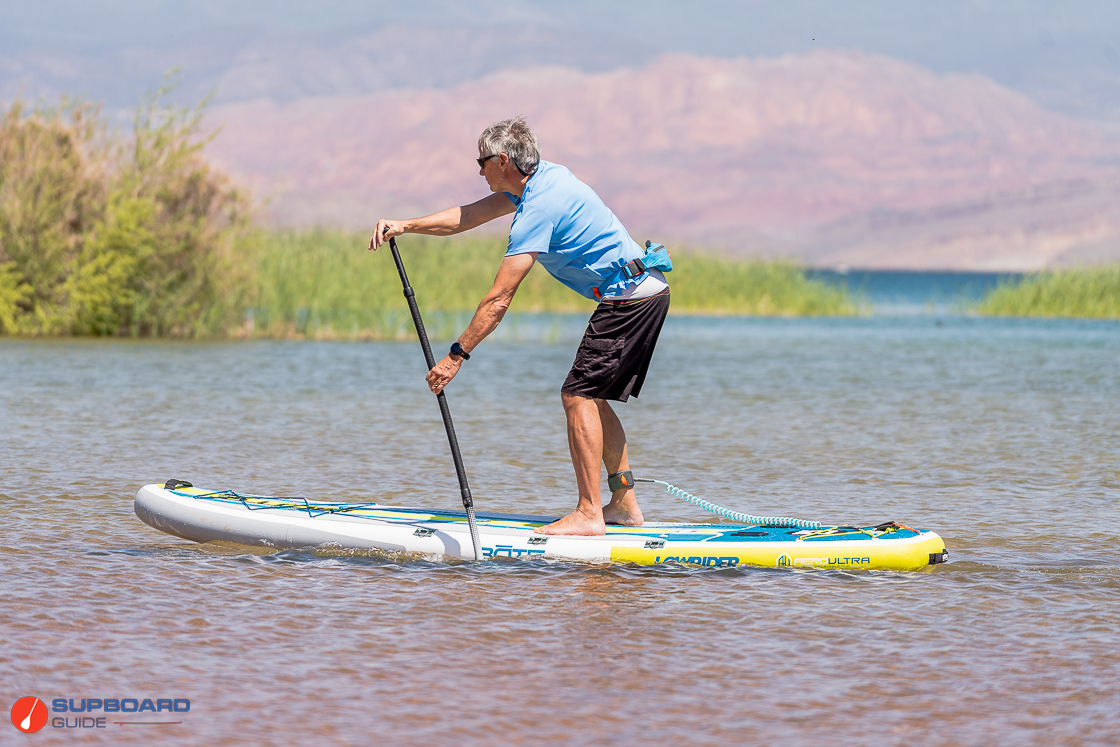
Normally, a super wide board isn’t going to score particularly well on tracking, because your paddle is a long way from the center line, making every stroke a turning stroke. The width forces your paddle shaft away from the ideal vertical orientation also, compounding the turning effect of each stroke.
Nevertheless, the Bote LowRider Aero 11’6 actually performs surprisingly well in this department, for two main reasons. Firstly, the extended bullet-shape outline with the width extending a long way back and the touring-style pointed nose, do a good job at holding the board onto its course.
Secondly, the three fins under the tail, including the huge center fin, really do a good job of locking the board onto its course. So overall, it actually tracks pretty well compared to other boards of this width, hence the above-average tracking score.
In kayak mode the tracking is great, whether you’re riding one up or two.
Maneuverability: 8.1/10

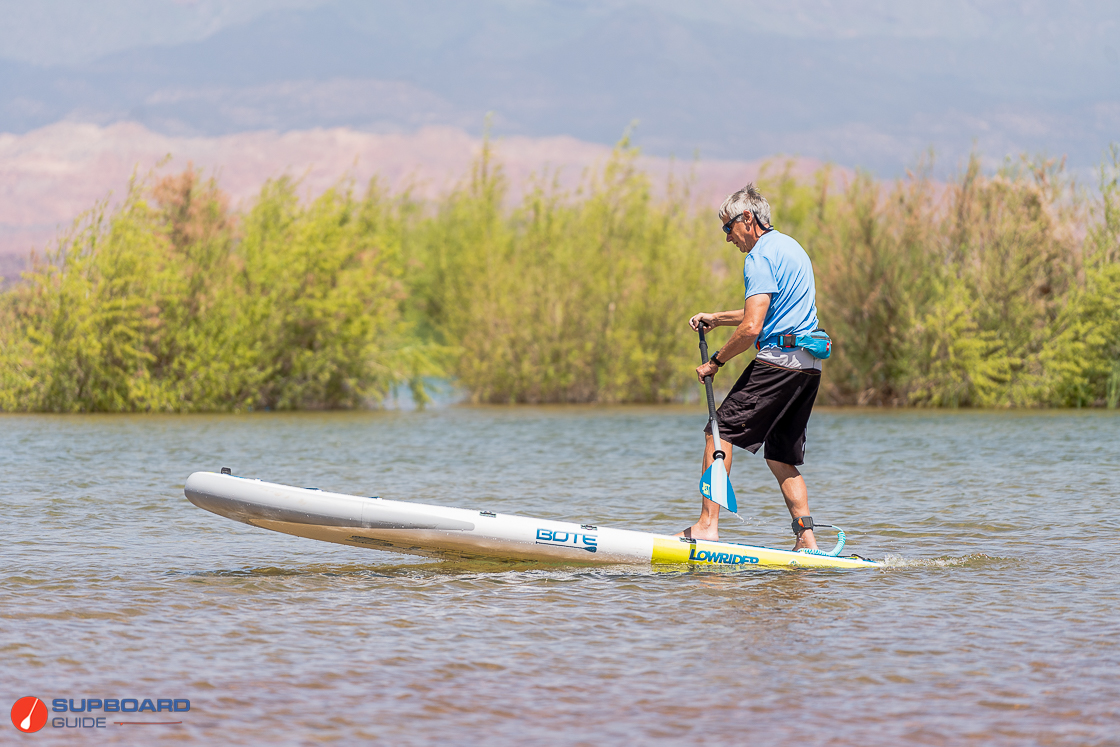
Maneuvering isn’t really where the LowRider Aero 11’6 excels, due to its extra width and length. The bottom line is that there’s a large area of board there to turn!
As explained in the previous section, the board has above average tracking capabilities. And those features which make it easy to keep on a straight line – that bullet-like plan shape, and the big fin area under the tail – are now working against us when we want the board to turn.
So it takes more than an average amount of strokes to turn the board using paddle turning techniques such as sweep turns and rudder turns. However, the large wide tail makes it easy and fun to step back for pivot turns.
In kayaking mode it’s also more of a straight line craft than a super maneuverable machine. Because you can’t easily lean into the turn like you would in a kayak, you have two choices; learn some advanced kayak turning techniques, or just put up with the fact that it takes a bit longer to turn. Two up is easier if you work together, but it still takes quite a bit of effort.
Construction Quality: 8.5/10

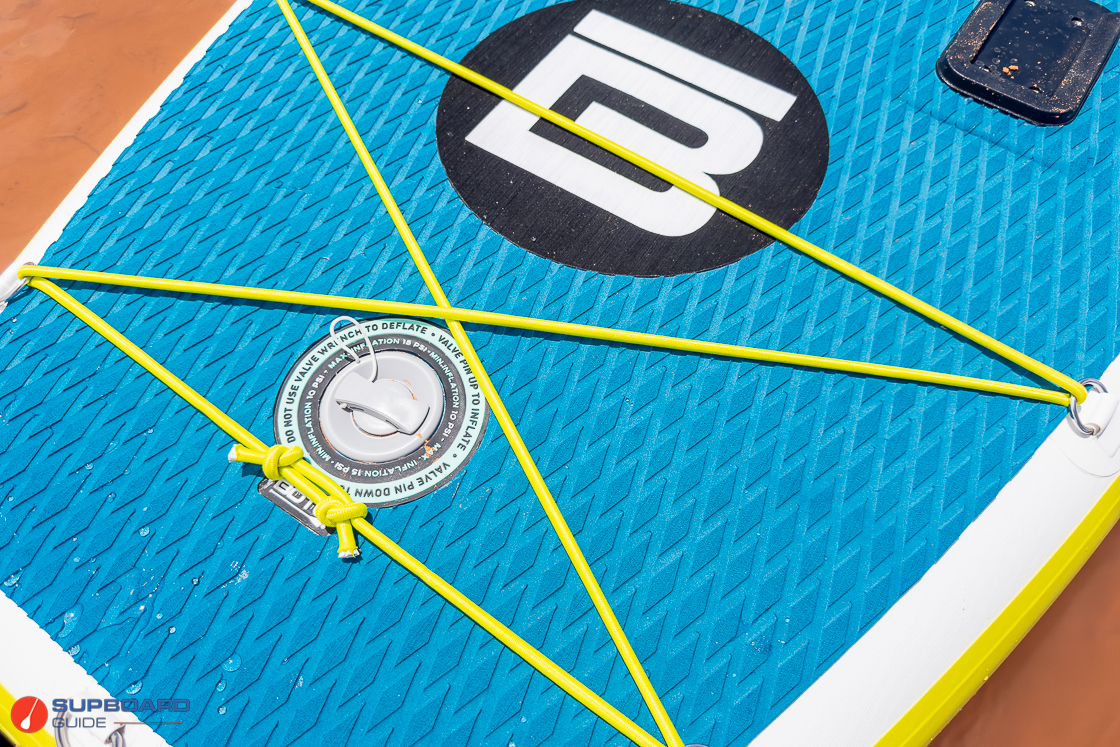
The LowRider Aero 11’6 is built using Bote’s lightweight single-layer AeroUltra construction technology, which sees a single outer layer of PVC fused to the fabric base layer of the knitted drop stitch core. Two layers of PVC are used at the sides, to add additional durability where it’s most needed.
While it’s still somewhat more flexy in feel than double layer boards, this ‘single layer fusion’ approach is becoming increasingly popular in iSUP construction, as it’s much lighter than the double-layer construction techniques and yet more durable and leak-proof than the simple single layer construction technique of a few years back, which was extremely flimsy.
Board Stiffness:

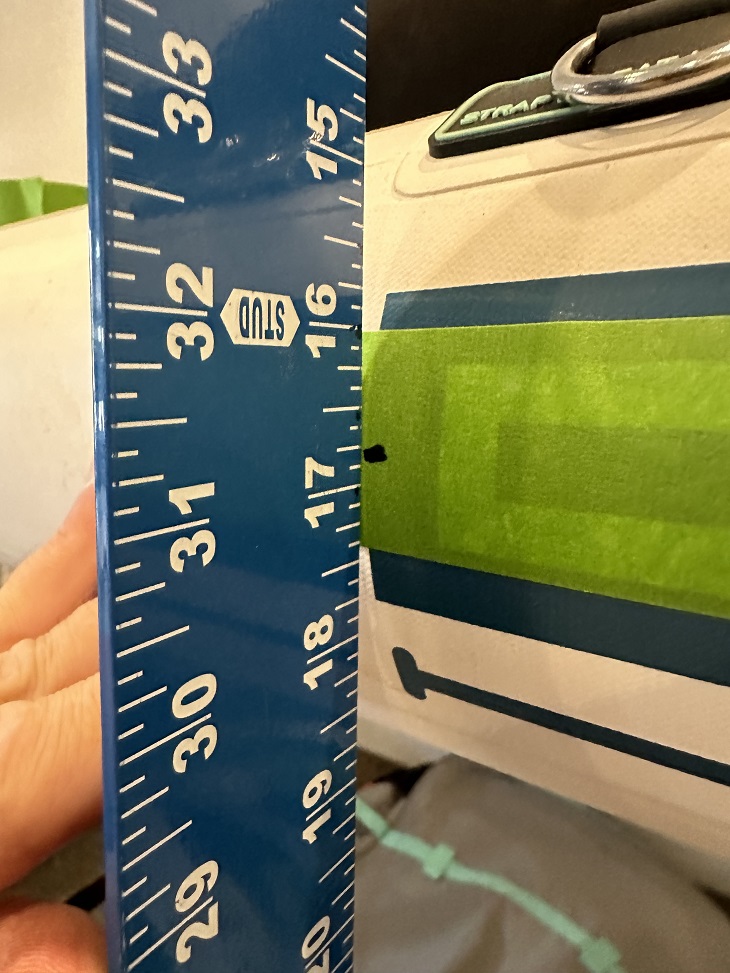
Stiffness Test: 1.25” Bend
The flex test result for the LowRider Aero 11’6 gave a result of 1.25” of deflection, which is reasonably good for a board built with single-layer construction. On the water, the flex isn’t particularly noticeable when just cruising around, particularly if you’re in multi-person mode. It’s only when you’re moving around on the board that you can feel it flexing under you, or when you attempt to paddle the board faster.
To ascertain the rigidity of each board we review, we use our own specific laboratory bend test process. The board is inflated to its maximum recommended PSI and then placed across two sawhorses positioned exactly 7 feet apart. We then measure the distance from the middle of the board to the floor. Then, we place a 150 lb weight on the middle top of the SUP, and measure the distance to the floor again. The difference between the two measurements shows the deflection, or ‘sag’, that the board has experienced due to the added weight. We have been reviewing the stiffness of boards using this technique since 2021 and while it isn’t an exact replication of the weight distortion that occurs when a rider stands on a SUP board in the water, it still gives a very useful comparative tool in determining the stiffness of the board’s construction process.
Features/Accessory Review: 9.0/10


Features:
As can be seen in the pic above, there’s plenty happening on the deck of the Bote LowRider Aero 10’6, not least that full size EVA foam deck pad, which instantly gives the board a whole lot more versatility. The nicely colored pad (BOTE’s “Full Trax” color scheme) has longitudinal drainage grooves to move water away from the standing area, and a more aggressively embossed pad in the tail area to give maximum grip when you’re standing further back.
There are cargo bungees on the nose and tail, and 3 substantial D Ring fitting points down each side for the kayak seats or other accessories such as a shoulder strap. The LowRider Aero 11’6 also has two Bote Magnepod accessory mounts on the center line, which can securely hold speakers, drink tumblers or other accessories without needing to screw or clip anything into place.


Behind the main seating/standing area there are the two mounts for the slide-in Aero Rac Receivers, which allow a whole range of versatile and ingenious Bote accessories to be mounted on the board, including the Kula coolers (for which there are an extra 2 D rings mounted on the deck.
The board has generously proportioned carrying handles in the center and on the nose and tail. The tail handle is on the rail rather than on the deck. In general we prefer deck-mounted handles as they’re more comfortable for carrying the board, and make rafting up with other paddleboarders on the water much easier.
The underside of the board has three finboxes. The center fin slides into its fin box mount, and is extremely large, significantly enhancing the board’s tracking and stability. The side fins are small and permanently fixed on. We question the value of these as they’re too small to be of any useful function, and being extremely toed-in they create quite a bit of drag. The board would be better off without them.


Included Accessories:
The Bote LowRider Aero 11’6 comes complete with everything required for two people to go kayaking or paddleboarding. It’s pretty impressive that it all fits surprisingly easily into the one travel bag! (Although be aware that the entire kit weighs nearly 50 lbs all up).
The paddles can be configured either as 3 piece adjustable SUP paddles, or the handle section swapped out for a second blade to turn it into a kayak paddle. The paddles feature a fiberglass shaft section, which is noticeably lighter and more comfortable to hold than the alu paddle that some of the other Bote models are equipped with.
The shaft has an extra grip sleeve added over the fiberglass, which is unusual. Most paddlers don’t need (or want) a grip sleeve because fiberglass is a comfortable and naturally grippy material to hold onto anyway, and rubber grip adds weight and isn’t great if you like to move your hands around on the shaft when paddling.
For those that do like the extra traction it’s extremely easy to add a grip sleeve at any time. So we’re not sure that this is the best way to go. It would probably make more sense to offer the grip sleeve as an additional accessory for those that want it.
The blade is made of ABS plastic; heavier than the nylon more commonly used in SUP paddles, but ABS is reckoned to be more durable, and these paddles certainly feel like they could handle some punishment.
The blade profile is smaller than that used in previous generations of Botes, and well suited to general purpose paddling and kayaking. All in all, it’s a decent paddle set up that suits the board well.
The other significant fittings are the inflatable kayak seats, which are extremely comfortable. They can be set to three different incline positions and provide excellent back support. The seat itself has an elevator pad which folds under the front, to lift your legs into a more comfortable position than you usually encounter with flat kayak seats.
The board has three sets of attachment positions for the seat. If you’re in tandem kayak mode you’ll use the front and rear positions (which leaves just about enough room in between for average height humans), but if you’re kayaking on your own then you can choose wherever you like to attach the seat.
Having just the one seat attachment strap on either side is OK but it does mean that the seat can still move while you’re sitting on it, particularly when you’re paddling harder or trying to turn. It would be great to have another attachment point on the seat so as to properly anchor it into place. As discussed elsewhere, a footrest option would be great too.
As for the other fittings, the Aero single chamber hand pump has a deflate mode as well as inflate. The center fin is huge, and of the slide-in variety, which sometimes takes quite a bit of effort to get into place, or remove after paddling. And finally, there’s the pair of Aero Rack receivers which slot into the base plates on the tail, for which Bote have a wide range of accessories, well worth checking out on their website.
Overall, it’s a comprehensive set of equipment that suits the board well.
Summary Review of the BOTE LowRider Aero 11’6
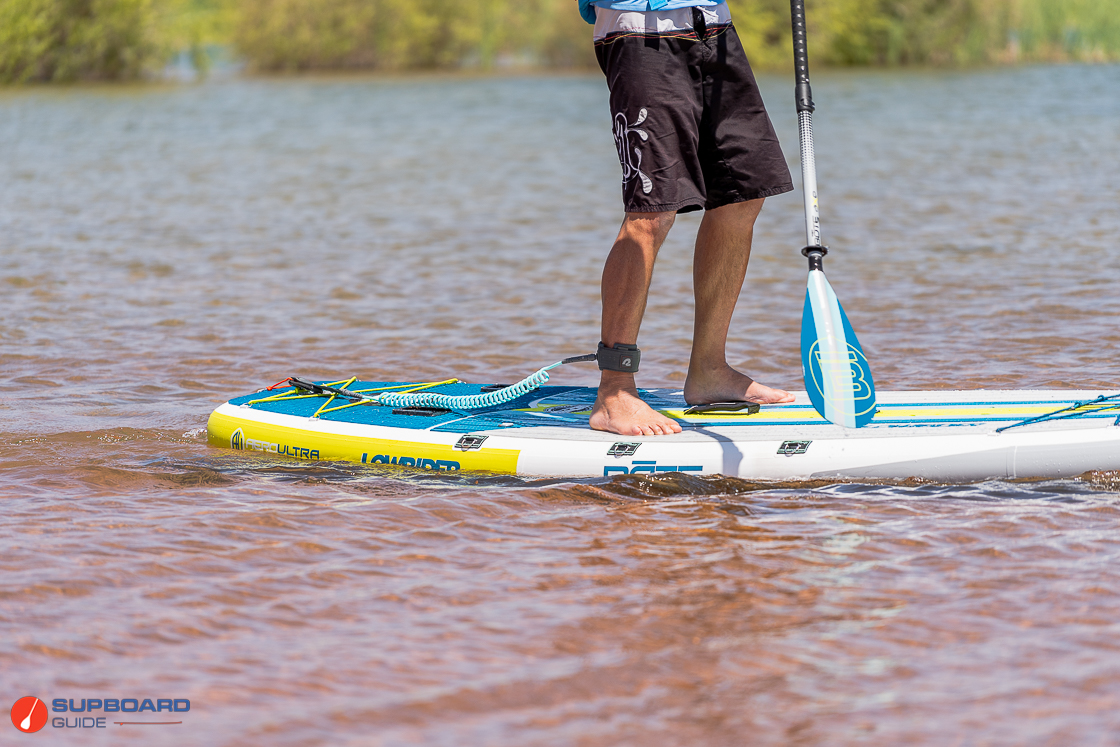
As mentioned at the start of this review, Bote have a number of SUP/kayak hybrids in their range. However,
The LowRider Aero 10’6 (the shorter sibling of the 11’6 reviewed here) is essentially an up-specced version of the EasyRider 10’4, both of which are functional and capable SUP/kayak hybrids, but for us it’s this model, the LowRider Aero 11’6 which stands out from the crowd, thanks to its tandem capabilities plus its extra stability and tracking performance. It’s a great package that opens up your on-water time to sharing with others, with the capacity to be used in a multitude of different modes. Nice one Bote!
Review of the BOTE LowRider Aero 10’6
So how does the BOTE LowRider Aero 10’6 compare to the 11’6? What does the 1’ reduction in length mean in practice? The easiest way to understand this will be to revisit each of the performance characteristics.
Stability
Being so wide, the Aero 10’6 is still extremely stable for a single person board, but being of the same construction of the 11’6, suffers similarly from the extra flex when under heavy load. So while it’s rated for 300 lbs we’d suggest that 250 lbs is probably a sensible upper limit for rider weight.
Speed
The reduced length has a direct impact here; the 10’6 is clearly a bit slower than the 11’6.
Tracking
As with the speed, the tracking characteristics of the board reduce from good to average.
Maneuverability
This is the parameter where the reduced length definitely pays off; the board is noticeably more lively in feel.
The construction is the same on both boards, so no difference there. As for features and accessories, the obvious difference is that the Aero 11’6 comes equipped for two paddlers (thus two paddles and two seats), while the 10’6 is designed to be paddled solo, so it comes with one paddle and one seat. It also has just the one Magnepod holder. However, the fittings are otherwise identical.
Summary
The LowRider Aero 11’6 costs $100 more than the LowRider Aero 10’6, but for that extra $100 you are getting more than just a second paddle and kayak seat. We suspect that for most buyers, the extra stability, speed and tracking of the bigger board will be more beneficial than the the extra maneuverability of the shorter board. So our recommendation is that, unless you absolutely never intend to ever paddle with anyone else, the 11’6 is the better package overall.
Happy paddling! We hope you enjoyed this review of the BOTE LowRider Aero boards. If you have any questions or comments please leave us a comment below!
SupBoardGuide
Latest posts by SupBoardGuide (see all)
- Hala Radito Whitewater iSUP Review – 2025 - June 27, 2025
- Hala Atcha 96 Whitewater iSUP Review – 2025 - June 16, 2025
- Thurso Surf Expedition 150 iSUP Review – 2025 - June 12, 2025


